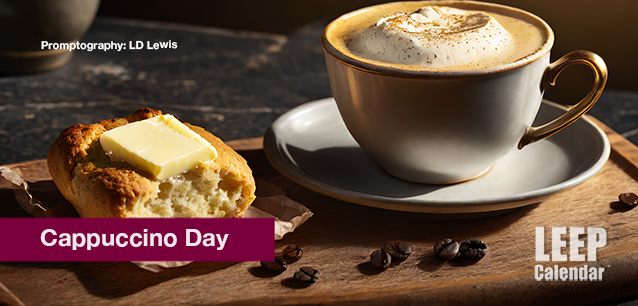 AD
AD
Today is: November 24
Scroll to explore events active on this date.
Additional Events on LEEP
LEEP INK FEATURES

August? Absolutely!
In August, we live through the Dog Days of Summer. It's hot and often humid, and those who can leave for better climates do. Down south, winter is in full force. August is also known as "the ...

In The Heat of July: July 2025 Events
Is it hot enough (or cold enough if you're below the equator) for you yet? There is actually a day for that! Like every month, I pick a diverse collection of events you may or may not know about. This ...

May Blooms: Events in May 2025
Along with October, May is one of the most densely packed months of the year. It's before the summer humidity and the last whole month of the school year. The weather is warming in t...
About Cappuccino Day
Ends: Nov 08, 2025
DESCRIPTION:
Cappuccino Day celebrates the coffee drink.
The cappuccino, known for its rich espresso, hot milk, and frothy milk foam, has a history that spans centuries and crosses cultures. This popular beverage originated in Italy and has evolved over time into the iconic coffee experience enjoyed worldwide today.
Cappuccino dates back to the 17th century, coinciding with the introduction of coffee in Europe. The name "cappuccino" is thought to have been inspired by the Capuchin friars, an order of monks known for their brown robes. The color of the espresso mixed with frothed milk resembled the Capuchin robe, leading to the moniker.
However, the modern version of the cappuccino developed in the 20th century with the invention of the espresso machine. In the early 1900s, espresso machines appeared in Italian coffee bars, enabling baristas to make a more robust, more concentrated coffee. The cappuccino as we know it began to take shape in the 1930s with the addition of steamed milk and milk foam to espresso.
The post-World War II era saw significant advancements in espresso machine technology, particularly with machines capable of producing a higher pressure, leading to a finer espresso and a creamier foam, essential elements of today's cappuccino. The drink started gaining popularity outside Italy, especially in other parts of Europe and the United States.
The cappuccino's popularity surged in the latter part of the 20th century with the rise of specialty coffee culture. Coffee shops and cafes, particularly in the United States and Europe, began to feature cappuccinos as a menu staple, often experimenting with various sizes, types of milk, and even flavor additions.
Today, cappuccino is lauded for its balance of flavors and textures: the espresso's richness, the milk's creaminess, and the foam's lightness. It is often enjoyed in the morning, especially in Italy, but has become a coffee favorite at any time of day worldwide.
VIDEOS
SUPPORTING DOCUMENTS
Currently, this event does not have supporting documents.
ADDITIONAL IMAGES
Currently, this event does not have supporting images.
Where would you like to go now?
 AD
AD


/footer-logo.svg)
